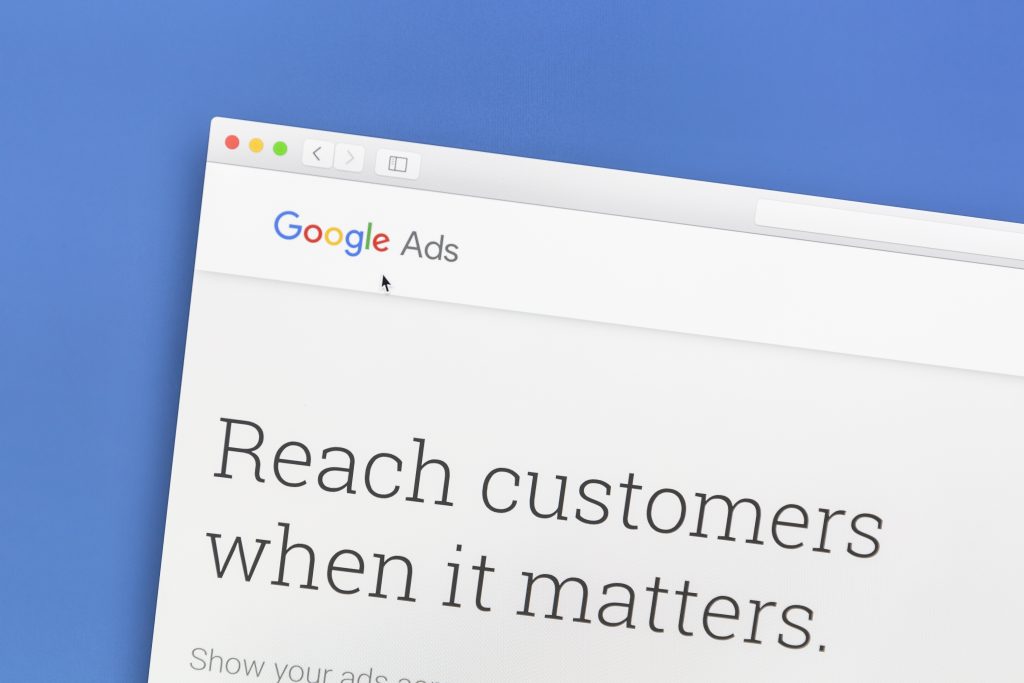
Using Google Ads for Your Business
According to Hubspot, Google processes approximately 63,000 search queries every second, translating to roughly 5.6 billion searches per day and 2 trillion global searches per year. In fact, Google now controls 92% of the search engine market share, making them the definitive authority for online queries. Google has become more than just a place to find out how many quarts are in a gallon (4) or who won the American League MVP award in 1961 (Roger Maris); it now offers individuals the ability to research, communicate with, and eventually purchase from businesses providing both products and services.
What if there was a way to boost your presence on Google, giving you a leg up on the competition?
Many businesses today are still not advertising on Google or through a paid search campaign. They continue to spend their budget on older methods that may have worked for them in the past, including radio, TV advertising, billboard, local publications, mailers, and other out-of-home media. However, they’re neglecting the future of digital marketing: Google Ads.
With the help of Google Ads, a business can target its advertising spend to increase its reach, obtaining more leads, conversions, and ultimately, sales in the process.

What are Google Ads?
Google Ads enable a business to advertise its products and services with the use of relevant keywords. When someone types in a query on Google (a keyword), they are promptly taken to a search engine results page (SERP) with relevant information. The SERP will contain a list of results, including a paid advertisement at the top and bottom of the page. In working with Google Ads, businesses aim to be somewhere in the top four spots as that generally yields the highest number of clicks. In short, Google Ads help obtain leads and increase brand awareness while ensuring that your website is continually receiving relevant clicks.
How do Google Ads work?
Google Ads uses a pay-per-click (PPC) model wherein companies or businesses will target keywords that they feel are relevant to their business. Once they’ve decided on the keywords they want to advertise for, they will “bid” against others advertising with the same keyword. These bids are the maximum you’re willing to pay for your ad and a prospective click. That means that if you and a competitor are bidding on the same keyword and you have the higher bid, you’ll get the ad placement. There is also an option wherein you can input a maximum daily budget for your ad.
Google Ads users have three bidding options. They are:
Cost-per-click (CPC) – How much are you willing to spend to have someone click on your ad?
Cost-Per-Thousand Viewable Impressions (vCPM) – How much are you willing to spend for 1,000 viewable impressions?
Cost-Per-Action (CPA) – How much are you willing to spend for a conversion from your ad?
What types of Google Ads are there?
Google offers a few different options when it comes to advertising. They are:
Search – these text ads will appear on the SERP for pre-selected keywords at the top and bottom of a page.
Display – these banner ads will appear on various partner websites affiliated with Google, including pre-roll for YouTube videos.
Shopping – these ads enable you to feature a product image on the SERP page and display your ad on the Google Shopping page.
Video – these video ads are hosted by YouTube and other partner sites/apps.
App – these visual-banner ads will display in various Google-affiliated applications.
How much do Google Ads cost?
The cost of a Google Ad will vary depending on how competitive the keyword and what Google determines the quality score of your ad to be. Google calculates an ad’s quality score by assessing the relevance of your ad and the website it links to to the person completing the search.
What keywords should I target in my Google Ad?
When deciding on what keywords to target for your Google Ads, Google Keyword Planner is a recommended resource that helps you research the best keywords for your business.
With Google Keyword Planner, you search for words and phrases related to your business. The website will then provide insights on how competitive the keyword is, how much you should expect to bid for this keyword, and the average number of monthly searches. Google Keyword Planner can also help you brainstorm other similar keywords that you might not have previously considered. The best part is, it’s completely free.
What makes an effective Google Ad?
While advertising formats may vary depending on overall goals, budget, and company needs, one thing remains the same across all platforms: your messaging must be clear, concise, and able to capture the interest of your audience.
For search advertisements, writing crisp copy is of paramount importance, but this comes with its challenges. Not only do you need to craft a compelling message that will stand out in a sea of other similar messages, but you need to do so within the confines of the character and space restrictions established by Google. You want a consumer to click on your advertisement, so it needs to stand out, but how do you do so when such limitations abound?
When it comes to writing copy for search ads, brevity and clarity are essential. You must get your message across quickly and impact the consumer before another search engine result beats you to it. Maybe you attempt humor, try to elicit an emotional response, or even attempt to lure your audience in with a coupon or special offer. Whatever you decide to do, make it interesting. A dull and poorly written ad is a waste of time and money for you and your business.
How do I measure success in Google Ads?
A multitude of metrics exists that can help you measure success with regard to your Google Ads. Here are a few of the major ones:
CTR (Click-Through-Rate) – CTR is the number of users, per 100 impressions, who click on your advertisement and arrive on your landing page. Per Wordstream, the average CTR across Google search ads is just under 2%, but that number can vary depending on the business sector or field.
CvR (conversion rate) – CvR is the number of users who, once on your landing page, take the desired next step you’ve put in place for them. Perhaps it’s filling out a form or answering some questions. The conversion rate is calculated by taking the number of conversions and dividing it by the number of people who clicked on your link to visit the website.
Cost/Conversion – The cost per conversion tells you how much, on average, each of your conversions costs. This number is calculated by dividing your total cost by the number of conversions you have obtained.
Quality Score – Google Ads will determine how useful your ad and the website it links to are to the person who sees it. This assessment will result in a quality score, which can be monitored via a Google Ads account.
The Bottom Line on Google Ads
Google Ads offers businesses the opportunity to engage with potential consumers with minimal effort or cost. By establishing goals, crafting simple messaging, and allocating a reasonable budget, Google Ads can significantly impact your business. With roughly 180,000 search queries made on Google since you started reading this paragraph, Google Ads provides unparalleled opportunities to reach potential customers.
Are you interested in learning more about how Mobile Marketing can help you improve your Google Ad work, finding you leads and customers in the process? We’re currently offering free digital assessments wherein we’ll work with you to discuss possible improvements to your digital marketing strategy and put a strong Google Ads campaign together for your company or business. Contact us today!
